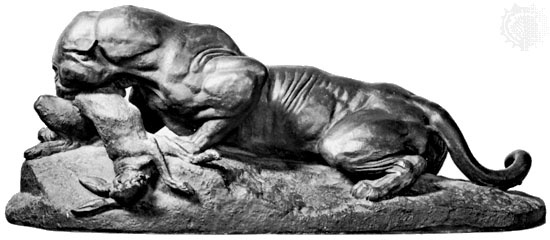Barye, Antoine-Louis
French sculptor, painter, and printmaker
born Sept. 24, 1795, Paris, France
died June 25, 1875, Paris
prolific French sculptor, painter, and printmaker, whose subject was primarily animals. He is known as the father of the modern Animalier school.
The son of a jeweler, Barye was apprenticed to an engraver of military equipment at age 13; after serving in the army, he worked for a time in the jewelry trade. In about 1817 he began to sculpt while working in the studio of the sculptor François Bosio. He was also influenced by the Romantic paintings of Théodore Géricault. From 1823 to 1831 he worked with Jacques-Henri Fauconnier, a goldsmith.
 Barye's talent for rendering dynamic tension and exact anatomical detail is especially evident in his most famous bronzes, those of wild animals struggling with or devouring their prey.
Barye's talent for rendering dynamic tension and exact anatomical detail is especially evident in his most famous bronzes, those of wild animals struggling with or devouring their prey.Barye gradually gained a reputation as a monumental sculptor with government commissions for images of wild animals in the 1830s, figure groups and portraits for the facade of the Louvre in the 1850s, and freestanding Napoleonic monuments in the 1860s. He first exhibited his bronzes at the Salons of 1827 and 1831, receiving a second prize for his Lion Devouring a Gavial. He withdrew from exhibiting in the Salon in the 1830s after a celebrated small-scale project was rejected as goldsmithery (i.e., not “high art”), but he returned in 1850, to great acclaim.
Generally speaking, Barye was responsible for having improved the status of animal sculpture, a category famous since antiquity, and for demonstrating its suitability as a modern expressive form. He also gained special fame as an artist who, regardless of subject matter, could meld grandeur and artistic refinement with realism in both public monuments and in small-scale bronzes for the home at a wide range of prices that the middle class could afford.
Additional Reading
Glenn F. Benge, Antoine-Louis Barye: Sculptor of Romantic Realism (1984).
- Edward Patrick Morris Morris, 1st Baron
- Edward P. Jones
- Edward Preble
- Edward Prentiss Costigan
- Edward Randolph
- Edward Reilly, Jr. Stettinius
- Edward Reilly Stettinius, Jr.
- Edward Reynolds Pease
- Edward Riley Bradley
- Edward R Murrow
- Edward Robinson
- Edward Said
- Edwards, Alfred George
- Edward Samuel Corwin
- Edward Sapir
- Edwards, Gareth
- Edwards, John
- Edwards, Jonathan
- Edwards, Jorge
- Edwards, Lewis
- Edward Somerset, 2nd Marquess of Worcester
- Edward Somerset Worcester, 2nd Marquess of
- Edwards, Sir Owen Morgan
- Edward Stafford, 3rd Duke of Buckingham
- Edward Stafford Buckingham, 3rd Duke of